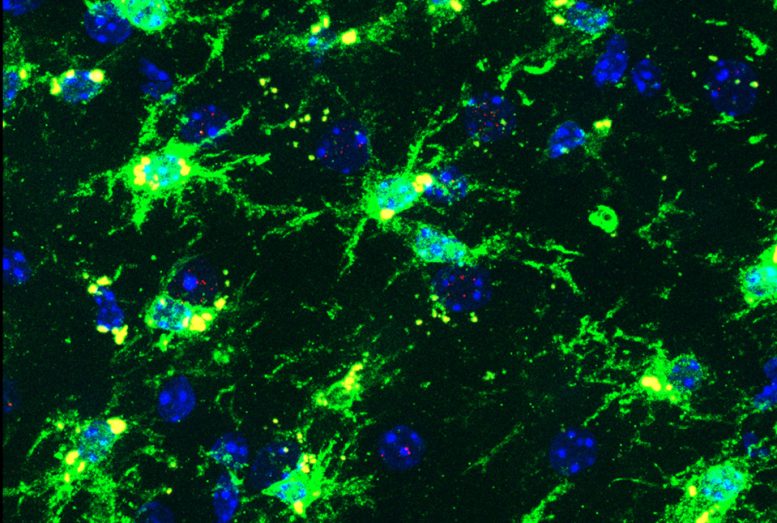

Researchers discovered that two genetic variants, APOE4 and TREM2 R47H, increase Alzheimer’s disease risk by triggering inflammation in the brain’s immune cells, particularly in females. This research underscores the need for sex-specific treatments and reveals a potential new therapeutic target, the cGAS-STING pathway.
Investigators at Weill Cornell Medicine have discovered that two genetic variants associated with a high risk of Alzheimer’s disease activate a detrimental inflammatory response in the brain’s immune cells, especially in females, according to a preclinical model study.
The findings, published in Neuron, emphasize the importance of considering sex differences in Alzheimer’s research – a step that could ultimately lead to more precise and effective treatments.
AD affects millions of people worldwide, with women disproportionately impacted – nearly twice as many females develop the disease compared with males. To advance therapeutic approaches, investigators are trying to determine the basis for these differences in vulnerability. Previous studies have shown that a gene variant called APOE4 increases AD risk more in women compared with men. The current study zeroed in on cellular activities that go awry when APOE4 and a variant of the TREM2 gene, which also raises AD risk, are present together in females. Because the proteins encoded by these genes have a variety of functions in cells, it has been unclear how the particular variants contribute to a vulnerability to the disease.
Insights into APOE4 and TREM2 Gene Variants
“Although these are two of the strongest risk factors for AD, little is known about how they enhance disease risk and they have not been often studied together,” said senior author Dr. Li Gan, director of the Helen and Robert Appel Alzheimer’s Disease Research Institute and the Burton P. and Judith B. Resnick Distinguished Professor in Neurodegenerative Diseases in the Feil Family Brain and Mind Research Institute at Weill Cornell Medicine. “Our goal was to combine these risk factors to highlight what pathways are altered when the risk of disease is strongest.”

Dr. Gan and her team, including lead author Dr. Gillian Carling, a graduate student in the Weill Cornell Medicine Graduate School of Medical Sciences at the time of the study, established mouse models for AD carrying human versions of APOE4 and TREM2 R47H, a rare variant that increases AD risk 2-4.5-fold. The mice also carried a mutation that leads to the development of clumps of tau protein—abundant in AD brains and closely associated with cognitive decline in patients. The team examined the mice at 9-10 months of age, roughly equivalent to middle age in humans, to assess how these genetic variants impacted brain health.
They found that female, but not male, mice with both APOE4 and TREM2 R47H exhibited significant damage to the brain region that plays an important role in thinking and memory. This damage included more severe tau protein clumps compared with those mice without these gene combinations.
The researchers attributed the damage in these female brains to the brain’s immune cells, called microglia. Normally, microglia protect the brain, but in this case, they became “senescent”, referring to aged cells that lost their ability to function properly. Instead of cleaning up damaged cells and protein clumps, these aged microglia linger around and release inflammatory chemicals through a pathway known as cGAS-STING. Notably, the study found that these harmful effects were more pronounced in female mice, a finding that aligns with reports that APOE4 poses a stronger risk for women than men.
Potential for Tailored Alzheimer’s Treatments
“Our research showed that when the two Alzheimer’s risk factors are combined in females with tau aggregates, the cGAS-STING pathway becomes highly activated,” Dr. Carling said. Suppressing this deleterious pathway lowered harmful inflammatory factors and rescued the aging phenotype in microglia.
The study underscores the need to consider sex differences in Alzheimer’s research and treatment, the researchers say, as the disease may progress differently in men and women and therefore may require tailored approaches, commented Dr. Gan.
By identifying the role of immune pathways like cGAS-STING in the progression of Alzheimer’s, particularly in individuals with high-risk genetic variants, the researchers hope to open the door to new strategies for treatment—and potentially prevention.
Reference: “Alzheimer’s disease-linked risk alleles elevate microglial cGAS-associated senescence and neurodegeneration in a tauopathy model” by Gillian K. Carling, Li Fan, Nessa R. Foxe, Kendra Norman, Man Ying Wong, Daphne Zhu, Carlo Corona, Agnese Razzoli, Fangmin Yu, Allan Yarahmady, Pearly Ye, Hao Chen, Yige Huang, Sadaf Amin, Rebecca Sereda, Chloe Lopez-Lee, Emmanouil Zacharioudakis, Xiaoying Chen, Jielin Xu, Feixiong Cheng, Evripidis Gavathiotis, Ana Maria Cuervo, David M. Holtzman, Sue-Ann Mok, Subhash C. Sinha, Simone Sidoli, Rajiv R. Ratan, Wenjie Luo, Shiaoching Gong and Li Gan, 30 September 2024, Neuron.
DOI: 10.1016/j.neuron.2024.09.006

